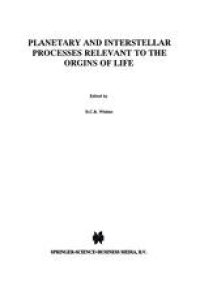
Ebook: Planetary and Interstellar Processes Relevant to the Origins of Life
- Tags: Planetology, Astronomy Observations and Techniques, Astrophysics and Astroparticles, Meteorology/Climatology, Evolutionary Biology
- Year: 1997
- Publisher: Springer Netherlands
- Edition: 1
- Language: English
- pdf
These are exciting times for exobiology. The ubiquity of organic molecules in interstellar clouds, comets and asteroids strongly supports a cosmic perspective on the origin of life. Data from both ground-based telescopes and the recently launched Infrared Space Observatory are providing new insight into the complexity of carbon-based chemistry beyond the Earth. Meteorites give us solid evidence for extraterrestrial amino acids, and putative fossil evidence for life in a 3.6 billion-year-old Martian meteorite hints that life in our system might not be the sole prerogative of the Earth. Giant planets have now been discovered orbiting other stars, and although such planets seem unlikely to be habitable themselves, their existence strongly suggests what many astronomers have long believed - that planetary systems are commonplace.
All these topics are reviewed in this volume by active researchers. The level is appropriate for graduate students in astronomy, biology, chemistry, earth sciences, physics, and related disciplines. It will also provide a valuable source of reference for active researchers in these fields.
These are exciting times for exobiology. The ubiquity of organic molecules in interstellar clouds, comets and asteroids strongly supports a cosmic perspective on the origin of life. Data from both ground-based telescopes and the recently launched Infrared Space Observatory are providing new insight into the complexity of carbon-based chemistry beyond the Earth. Meteorites give us solid evidence for extraterrestrial amino acids, and putative fossil evidence for life in a 3.6 billion-year-old Martian meteorite hints that life in our system might not be the sole prerogative of the Earth. Giant planets have now been discovered orbiting other stars, and although such planets seem unlikely to be habitable themselves, their existence strongly suggests what many astronomers have long believed - that planetary systems are commonplace.
All these topics are reviewed in this volume by active researchers. The level is appropriate for graduate students in astronomy, biology, chemistry, earth sciences, physics, and related disciplines. It will also provide a valuable source of reference for active researchers in these fields.
These are exciting times for exobiology. The ubiquity of organic molecules in interstellar clouds, comets and asteroids strongly supports a cosmic perspective on the origin of life. Data from both ground-based telescopes and the recently launched Infrared Space Observatory are providing new insight into the complexity of carbon-based chemistry beyond the Earth. Meteorites give us solid evidence for extraterrestrial amino acids, and putative fossil evidence for life in a 3.6 billion-year-old Martian meteorite hints that life in our system might not be the sole prerogative of the Earth. Giant planets have now been discovered orbiting other stars, and although such planets seem unlikely to be habitable themselves, their existence strongly suggests what many astronomers have long believed - that planetary systems are commonplace.
All these topics are reviewed in this volume by active researchers. The level is appropriate for graduate students in astronomy, biology, chemistry, earth sciences, physics, and related disciplines. It will also provide a valuable source of reference for active researchers in these fields.
Content:
Front Matter....Pages i-iii
Commentary....Pages 1-1
Origin of the Biologically Important Elements....Pages 3-21
Circumstellar and Interstellar Synthesis of Organic Molecules....Pages 23-51
Detection of Organic Matter in Interstellar Grains....Pages 53-78
The Nature and Evolution of Interstellar Ices....Pages 79-100
Interstellar Ices Studied with the Infrared Space Observatory....Pages 101-113
The Search for Interstellar Glycine....Pages 115-133
The Origin of Low Mass Stars....Pages 135-155
Analogs of the Early Solar System....Pages 157-184
The Early Solar System....Pages 185-203
Physics and Chemistry of the Solar Nebula....Pages 205-224
Chemical Evolution on Titan: Comparisons to the Prebiotic Earth....Pages 225-248
Is Extraterrestrial Organic Matter Relevant to the Origin of Life on Earth?....Pages 249-262
The Search for Life on Mars....Pages 263-289
Habitable Zones Around Low Mass Stars and the Search for Extraterrestrial Life....Pages 291-307
Back Matter....Pages 309-316
These are exciting times for exobiology. The ubiquity of organic molecules in interstellar clouds, comets and asteroids strongly supports a cosmic perspective on the origin of life. Data from both ground-based telescopes and the recently launched Infrared Space Observatory are providing new insight into the complexity of carbon-based chemistry beyond the Earth. Meteorites give us solid evidence for extraterrestrial amino acids, and putative fossil evidence for life in a 3.6 billion-year-old Martian meteorite hints that life in our system might not be the sole prerogative of the Earth. Giant planets have now been discovered orbiting other stars, and although such planets seem unlikely to be habitable themselves, their existence strongly suggests what many astronomers have long believed - that planetary systems are commonplace.
All these topics are reviewed in this volume by active researchers. The level is appropriate for graduate students in astronomy, biology, chemistry, earth sciences, physics, and related disciplines. It will also provide a valuable source of reference for active researchers in these fields.
Content:
Front Matter....Pages i-iii
Commentary....Pages 1-1
Origin of the Biologically Important Elements....Pages 3-21
Circumstellar and Interstellar Synthesis of Organic Molecules....Pages 23-51
Detection of Organic Matter in Interstellar Grains....Pages 53-78
The Nature and Evolution of Interstellar Ices....Pages 79-100
Interstellar Ices Studied with the Infrared Space Observatory....Pages 101-113
The Search for Interstellar Glycine....Pages 115-133
The Origin of Low Mass Stars....Pages 135-155
Analogs of the Early Solar System....Pages 157-184
The Early Solar System....Pages 185-203
Physics and Chemistry of the Solar Nebula....Pages 205-224
Chemical Evolution on Titan: Comparisons to the Prebiotic Earth....Pages 225-248
Is Extraterrestrial Organic Matter Relevant to the Origin of Life on Earth?....Pages 249-262
The Search for Life on Mars....Pages 263-289
Habitable Zones Around Low Mass Stars and the Search for Extraterrestrial Life....Pages 291-307
Back Matter....Pages 309-316
....